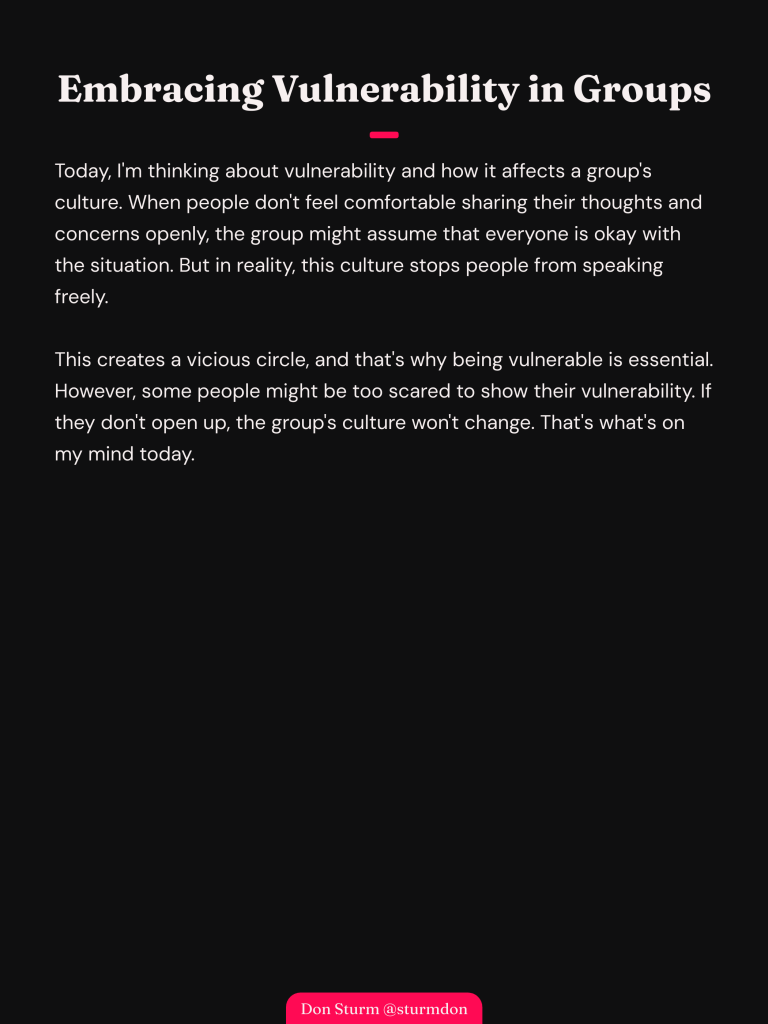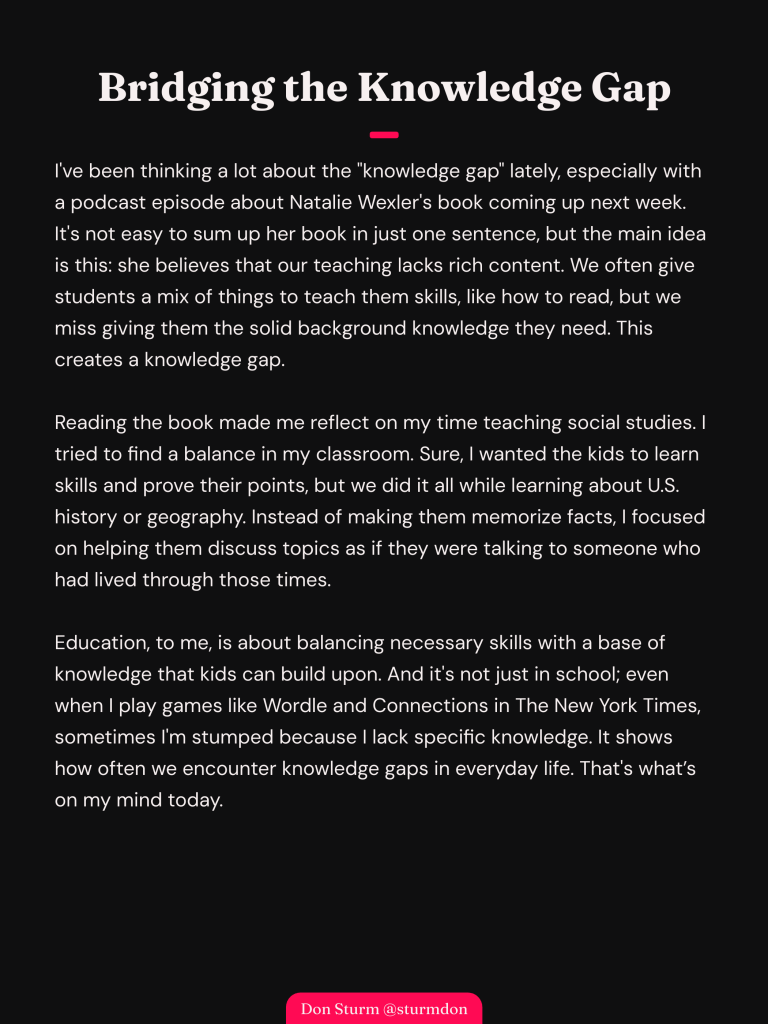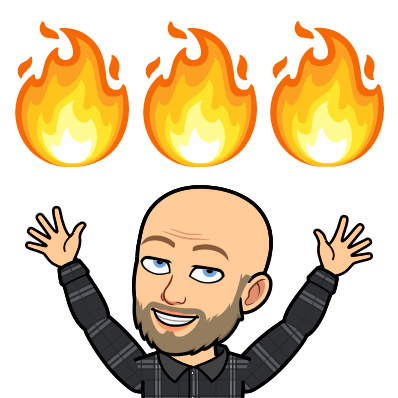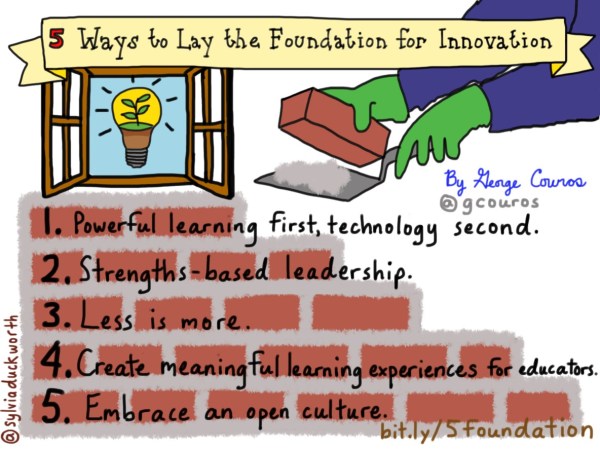










It has been a long time since I sat down to write a blog post. I could give a million excuses, but frankly, I just haven’t felt like writing one. The death of a friend has prompted me to write a new post. KathiSue Summers passed away from COVID on Saturday, August 28. It was heartbreaking news for everyone who knew and loved her. I never had the chance to meet her IRL (in real life). Wait… you never met her? How could her death have an impact on you? The answer is in the relationship we had built as members of an online PLN community through Voxer. Voxer is a platform that allows for voice and text communication. This community has been together for roughly four years, and we connect daily about topics ranging from education, our kids, favorite foods, etc. I know many of these people better than I know some teachers I have worked with for 30 years. We have had some great times and some rough times. We don’t always agree. Sometimes I get angry at them, and I am sure the reverse is true. Ok…I know the reverse is true. But, in the end, we are a community that cares for each other.
Some colleagues I work with “make fun” (in a joking sort of way) of these connections, but they are real friendships. My charge to you is to find your group and start connecting. How do you get started? Make your Twitter connections more than just a Twitter relationship. Take the leap and invite followers to join an app that allows you to share your thoughts using your voice. Voice brings so much more to the table than texts. You can hear passion, excitement, and sadness through voice. While Voxer is the app that #4OCFpln uses, others like Synth and Skilled Space allow for the same types of interactions. I have recently become friends with Sara Candela. We use both of these apps to stay in touch. Sara lives 2,000 miles from me; we have never met IRL, but I consider her a friend.
Even though I never met KathiSue Summers IRL, I am thankful for the online community that allowed me to get to know KathiSue and feel the loss over her death.
Don Sturm
Let’s Connect!
Voxer- @dsturm823

In my position, I spend a lot of time trying to convince educators to get connected by using Twitter and/or other social media platforms. Most of the time I tout the connections that can be made and how those newly formed connections can help to transform classrooms and schools. This blog post isn’t about all of those critical reasons but how to use hashtags as a way to document and retrieve what you are doing in the classroom. I recently attended an EdCamp in Central Illinois and was in a session discussing the need for and importance of connecting with others on social media. I didn’t need to be convinced, but when I mentioned the beauty of a service called Wakelet in being able to gather Tweets to help others see the power of connections, the light bulb starting going off. Simply put, Wakelet is a curation tool that allows you to add PDFs, links, images, Youtube videos, and Tweets all in a visually striking way. Here is an example of a Wakelet I made to show others the benefits of Seesaw. I started thinking about how teachers could leverage the power of hashtags to demonstrate their professional growth. I also need to give some credit to Carrie Bauchcum for helping me think through my ideas.
Hashtags are a way of categorizing information on social media sites like Twitter. While some users craft hashtags that are funny and sometimes only for one time use, consistent hashtags are a powerful way of being able to find information. Going to Twitter and searching #GrowthMindset will provide you with a plethora of information about the topic. Results might include GIFs, blog posts, images, etc. and can serve as a starting point for an exploration into this topic. My thought…what if we used personalized hashtags (#personalizedHT) to share information that we want to show others about what we are doing in our classroom and/or school?

There is probably a familiarity with the Danielson Framework as many districts use this model for teacher evaluations. Teachers are asked to provide specific evidence under each of the domains to help evaluators rate their overall efficacy. I think it is a common practice to leave this evidence gathering process to the last moment and then frantically try to gather what is needed for the summative evaluation. Imagine for a moment teachers working throughout the year to capture this evidence and sharing out the story of their classroom and pedagogy using Twitter. Each post could have a school hashtag as well as a personalized hashtag (#PersonalizedHT). I might post an image of a group of students effectively using the flexible seating in my room. Adding a hashtag like #sturm2e would record this as a piece of evidence for Domain 2e- Organizing Physical Space. This process would continue throughout the year and might include personal reflections, uploaded videos, self-reflections posts using an app like Periscope. The important part is that each Tweet is “coded” with at least one domain based on a specific personalized hashtag. Just a quick note on hashtags–No one owns them so if you come up with something really catchy, others can use it. Bland and boring might be a good rule of thumb for these hashtags.
Enter Wakelet. I love it because you can link your Twitter account to the service and pull in Tweets by account or hashtag. The person viewing the shared Wakelet does not have to have a Twitter account to be able to see the Tweets you have added. You see where I am going with this?? Create a Wakelet for each domain and every week or so (Twitter only allows Tweets to be searched 2 weeks back on Wakelet, though you can search for and add individual Tweets at any time while in Twitter) and do a search for the hashtags that corresponds to the relevant domain. This evidence is not limited to Tweets. You can add other items to the Wakelet to help present an accurate, real-world portrayal of you as a professional. Each Wakelet can be shared using a link with anyone needing to see the information.
I am excited to start using #PersonalizedHTs to document my learning and growth as an educator. How do you see them being used for yourself?
Don Sturm (@sturmdon)
The Complete Guide to Twitter Hashtags


As I take some time to reflect on 2018, it is apparent to me that this was the best year of my career. Other than a couple of years where I struggled to get a hold on the stresses of being a teacher, my career really has been a positive one, but this year was a particularly good one!
One reason is that I am finally comfortable with my position as a technology integration specialist after five years. When I was hired to be a tech integration specialist, I was thrown into a new 1:1 iPad initiative that meant learning on the job… every day! I always felt like I was behind the curve and was reacting to situations rather than looking ahead as I was used to doing in my classroom. As my district has become more comfortable with iPads, my position has turned into more of an instructional technology coaching position. This is where my passion lies, helping teachers to provide students a relevant education. Teachers view me as more than just a tech resource and contact me for instructional advice, rather than just a technology issue.
One huge impact on my 2018 has been the #4OCFpln of which I am an active member. This is a Voxer group that I was introduced to by Louie Soper (@mr_middle_2 ). I was in a direct message conversation with Louie and another social studies teacher about the idea of standards-based grading. During this conversation, Louie messaged me and said he had this “think tank” that I should consider joining. It has honestly been the best professional decision of my career. This group of passionate educators who I talk (yes, Voxer is a walkie-talkie app) with everyday challenges my beliefs and make me strive to be a better, more informed educator. I have had more rich educational discussions since I joined in May than I have had throughout my whole teaching career. This group is truly a family. Many of us are going to present at ISTE19 on the power of Voxer and social media connections, and we are all staying together in Philadelphia!

I have read more this year than I ever have. In fact, I think as I write this, I am on target to read 54 books. This surpasses my goal of completing 50 books in 2018. Most of these books have been non-fiction books focused on instructional strategies and education related topics. While I have always been a reader, it has been the #twomenandabook Voxer book studies that have upped my reading game. This online, asynchronous book study group was started by the founder of #4OCFpln Matt Larson (@mlarson_nj ) and Ricardo Garcia (@rokstar19). We conduct an in-depth study of one book a month. Invariably, each of the discussions brings up other books that “need” to be read. I am much more knowledgeable about the profession of teaching as a result of this book study group and my reading habit.
Lastly, my #OneWord2018 was CREATE, and create I did. One of my goals is to get teachers and students to realize the importance of creation using technology, not just consumption. As has been part of my position from the start, I continue to create tutorial videos for both students and teachers to help navigate the ever-changing world of technology. I create graphics with a quote of the day every day using Buncee (@Buncee ). This year also saw the creation of new professional development options that I call deep dives. These deep dives posit teachers into situations and discussions where they hopefully start to think deeply and reflectively about education topics. These deep dives have covered topics like assessment, grades, student engagement, creativity, and student voice and choice. I am also in the midst of writing a chapter and vignette for a member of #4OCFpln (@Rdene915 ) who is publishing a couple of books in the near future. While I am hoping they are good enough to be included, the process of writing down my thoughts about the changing nature of education over my career has been a valuable self-reflection exercise. In the wings is a podcast series with a 4th-grade student discussing books that she will choose. I am excited about this new endeavor because it does involve working directly with a student and sharing our joy of reading.
I am looking forward to starting 2019 with all of the positive habits of 2018. My new #OneWord2019 is dissonance. Getting educators to consider what education should look like for students in 2019 versus the current reality is an important step in making our schools better and more relevant for students. Here is to a great 2019!
Don Sturm

As I talk and work with those in positions to influence others, I am struck by the concern expressed that the change they are promoting isn’t happening fast enough. I get it…I have felt that way many times in the past. Honestly, I feel that way on a weekly basis. I think it is human nature to want to see the fruits of our labor as quickly as possible; however, it is also important for those wanting change to keep in mind that it does take time!
One way of looking at the issue of impact is to consider the simple graphic above. I am a space race fanatic and often think about those mathematicians and engineers in mission control during the lunar missions. If the mathematical calculations were off by one degree we would have missed the moon. One degree doesn’t seem like much but it is a big deal when amplified over 250,000 miles. A more relatable example of this would be if you have ever done a home improvement project. A “minor” eighth of an inch mistake at the beginning of a project will end twenty foot later as a giant mistake that might not be easily fixed. What if we think about educational change in this way but with a positive spin? It may not seem like the ideas and suggestions you are promoting are having an instant impact but consider what your school/classroom might look like after some period time has passed. That change you promoted gets implemented in a few classrooms, those students move to the next classroom, more teachers are indirectly impacted, those teachers decide to make a change and, before you know it, real change has happened.
There is some educational change that is much needed right now. I am not suggesting that we throw our hands up and wait for time to pass for each and every change, but it is also wise to remember the idea of change growing exponentially. A few strategic, small changes now might start the ball rolling for real, lasting, and necessary change to our educational system in the future.

I have always been a reflective person…maybe even to a fault. I know that I talk a lot. It is hard for me to keep my mouth shut and not offer an opinion or ask a question at meetings. I can be seen as pompous and overconfident at times. I genuinely like to help people. Troubleshooting is a strength of mine and, as a result, I tend to be a fixer. Ok…you get the idea, but the one aspect of me that I struggle with the most and want to change is that I know that I can be a firehose of ideas and thoughts.
To those who have experienced my soaking, I am passionate about what I believe is best for the kids in our schools. My passion can sometimes be a bit much for people. Add to that the animated nature of my personality and you have a full-blown firehose going on! Some colleagues joke around with me about this proclivity to push and throw out idea after idea, but I know that there is some element of truth to their kidding. I really do get it!
 My goal moving forward is to work to be more of a sprinkler than a firehose. People will still have the opportunity to get soaked, but it will be at their pace. Watch kids who run through a sprinkler. Some go full bore through it, some stand right on top of it, some hang back to get a little wet. This last type almost always ends up getting soaked once they get used to the temperature of the water or they see others having fun playing. This will be a challenge, but I think it is important for me to make this a goal. One way that I can work on this is to make sure that I am fully listening to those who ask for my help or advice. Truly hearing what teachers have to say will help me to better sense whether they are the run through the sprinkler full bore type of person or one that needs to feel the sprinkles for a bit before they commit to run through it.
My goal moving forward is to work to be more of a sprinkler than a firehose. People will still have the opportunity to get soaked, but it will be at their pace. Watch kids who run through a sprinkler. Some go full bore through it, some stand right on top of it, some hang back to get a little wet. This last type almost always ends up getting soaked once they get used to the temperature of the water or they see others having fun playing. This will be a challenge, but I think it is important for me to make this a goal. One way that I can work on this is to make sure that I am fully listening to those who ask for my help or advice. Truly hearing what teachers have to say will help me to better sense whether they are the run through the sprinkler full bore type of person or one that needs to feel the sprinkles for a bit before they commit to run through it.
My goal for the school year…Be a Sprinkler…Not a Firehose!
Don Sturm

As I was following my morning ritual of listening to my Voxer groups on the drive to work, I came across a challenge that started with Jessie Boyce and spread to fellow Voxer members Justin Schleider and Dene Gainey. The challenge…answer the question ‘Why do you love teaching?’ in 100 words, no more no less. Here is my 100 word challenge. A big sorry goes out to all the ELA teachers who will notice that there is a mix of present and past tense. This comes from the fact that I am no longer in the classroom, though I still consider myself a teacher.
Mrs. Holt, Mr. Williamson, Mr. Dyroff…these are the people who inspired me to teach, but I love teaching because of the kids. This sounds like the typical teacher answer, but I truly enjoy young people. I never knew what I would get each and every day that I walked into the classroom; it was never boring! Don’t get me wrong…there were hard days, but there was nothing like the satisfaction of seeing interest, engagement, and understanding from a class of students. Having students come back years later to say that they enjoyed my class also kept me going.
I would highly recommend that you take the challenge. It is not as easy as it looks!
Don Sturm

Though I have many unfinished posts in my draft section, it has been awhile since I have hit publish. Here goes my latest! I am fairly active on Twitter and my morning ritual is to Tweet out a quote on a background made with Buncee. Simple right?
Over the last couple of weeks I have had a few colleagues ask me about the purpose of this ritual. Their inquiries into my practice tend to be fairly nice and pleasant, though I sense the underlying feeling is that my morning routine is sort of a waste of time. I want to provide a little insight as to why I do what I do. Ultimately, I do it for no one other than myself. I post it publicly because that is what I preach to other teachers and students. Put your stuff out there! Create rather than consume! It just MIGHT resonate with someone else but, if not, I am ok with that as well.
The process I use to get and post the quote is the most important part of the ritual. It starts with thinking about what is important to me on that particular day. Monday might find me thinking about happiness, while Wednesday might be a growth mindset kind of day. Once I have my topic I set out to find the perfect quote. I read over a lot of them as well as trying to “verify” that the quote can be attributed to the person who is being claimed to have stated it. Sometimes I even to do some background reading on the person. This practice has lead to me reading book(s) by the person after finding out more about them. Laszlo Bock is a perfect example. I found a quote by him (see below) and ended up reading Work Rules!: Insights from Inside Google That Will Transform How You Live and Lead. Definitely worth a read!
If you’re comfortable with the amount of freedom you’ve given your employees, you haven’t gone far enough. –Laszlo Bock
My next task is to use Buncee to add a background and/or images. Here again, there is more to this than just picking the first image that comes to mind. I add, take away, add again, delete, etc. until I find the perfect visual to go with the quote. The wonderful thing about Buncee is the huge number of visual elements that can be pulled in to make just the right impression. All that is left is to post it for the world to see…or at least my followers!
So what makes this routine mean something to me? Simple…my brain is working and making connections. In my role as a technology integration specialist I preach that classrooms/teachers/students need to be doing more of this. I am trying to set the example that what I am doing has purpose if for no other reason than it makes my brain think and make connections. The quote and philosophy behind each image sticks with me because of the process, not the number of retweets or likes it receives. Just think of the possibilities if your students could be given more options to create products that were meaningful to them!
Simple right? Not by a long shot!
Here is a link to my Buncee Board where I have started to collect my quotes.

 It has been awhile since my last blog post, but now that the 2016-2017 school year is over it is time to think about next year. Summer is the time that teachers relax and regroup from the previous school year, but for many it is also the time to reflect on their teaching practice. I would argue that many times this is the only time when true reflection occurs. During the year we are often pulled in so many directions that is challenging to have meaningful and deep reflection. This post is meant to get you thinking about next year!
It has been awhile since my last blog post, but now that the 2016-2017 school year is over it is time to think about next year. Summer is the time that teachers relax and regroup from the previous school year, but for many it is also the time to reflect on their teaching practice. I would argue that many times this is the only time when true reflection occurs. During the year we are often pulled in so many directions that is challenging to have meaningful and deep reflection. This post is meant to get you thinking about next year!
Think about the times that you have walked through the woods. Most of the time is probably spent walking the worn path. While this might be done because of posted rules, many times it is done out of sheer convenience. Why wouldn’t you take a path that has already been forged? Think of all the difficulties of going off of that path. There are sticker bushes waiting to grab you. There is poison ivy all over. How will I know where I am going? People will think I am weird. Yes, all of those things could happen, but think about the possibilities waiting to be experienced off that path. When you take the worn path you are seeing and experiencing what others want you to see and experience. It is probable that the path offers the least resistance around an obstacle that lies ahead. Maybe the obstacle is worth admiring, not skirting around. Going off path might be challenging, but that is what makes it fun. You will see things that others have not.
Education is similar to that worn path in the woods. We do things the way that they have always been done because that is what is easiest or most convenient. Does this sound familiar…The way that I teach (fill in the blank) has to be done that way because that’s just how it is done. Economists use a term called path dependency to describe why people do what they do. Path dependency is simply the idea that past practice (history) dictates what we continue to do even if there might be new and better alternatives available. It is the worn path in the woods. There are advantages of that worn path in education. We know where we are going. We know how long it will take us. We know the obstacles that will be encountered. But…what are you and your students missing out on by being path dependent? There will be no way of knowing until you try.
My challenge to you is to try to walk off the path next school year. How can this be done? Read…there are all types of books written about ways that you can step out of the normal routine. These books don’t have to be purely subject specific. Jump onto social media and follow others who are stepping, or have stepped, off of the path. Pick their brains about what works and what doesn’t work. If you are one who wants to remain on the path, don’t stop others from going off course. This will be challenging for those schools that are departmentalized by subject or grade level because there is THE WAY that curriculum has to be taught. If you have someone who wants to try something new…LET THEM. If that teacher won’t be able to give the quiz on the same day as every other teacher because of this new way, the world will not come to an end. An even better alternative…agree to follow them as they step off the path. This type of action will be the only way that you will know if there is something better out there.
The transcendentalist Henry David Thoreau wrote Walden because he was tired of living life according to habit. He went into the woods to “live deliberately.” This is probably the familiar part of the story. What is important to know is that he left the woods, at least partly, because he saw himself falling into the same rut day after day. Don’t fall into a rut where all you do is take the path that has been forged for you.
“It is remarkable how easily and insensibly we fall into a particular route, and make a beaten track for ourselves. I had not lived there a week before my feet wore a path from my door to the pond-side; and though it is five or six years since I trod it, it is still quite distinct. It is true, I fear, that others may have fallen into it, and so helped keep it open. The surface of the earth is soft and impressible by the feet of men; and so, with the paths which the mind travels. How worn and dusty, then, must be the highways of the world, how deep the ruts of tradition and conformity.”
Henry David Thoreau
Walden


I am probably dating myself with this image, but I think Mikey can teach us a lesson…Sometimes you just have to try it! When considering the Week 4 blog challenge, the graphic “5 Ways to Lay the Foundation for Innovation” by George Couros resonates with me in my role as a technology integration specialist. 
I should mention that I am not a huge fan of that title because it seems to work against the first point in the graphic-Powerful learning first, technology second. I really see my role as more of an instructional coach, but I digress…point number four is my focus! The quest for educators who are in my position, no matter the title, is to get teachers to just try things. They may or may not like them, but they have to give new ideas and methods a try or they will never know. Sort of like trying brussel sprouts for the first time! With this in mind, I try to create learning situations where educators really have no choice but to try these new ideas. A couple of recent examples in my district come to mind.
The district administration team in my district was willing to let me run with an Edcamp style inservice in March. There were no administrators who were completely against the idea (at least I don’t think so), but there were some who were hesitant about trying this new idea. You can imagine the concerns:
I wish there were only four concerns, but the point…they said let’s do it, we did, and people liked it! There was nervousness from teachers on the day of the event, but generally the above concerns did not come to fruition. We had more than enough ideas to fill forty-five session slots and administrators just trusted that teachers would be where they were supposed to be! Surveying the participants after the event allowed them to share the good and bad of the event, but what we found overall is that people liked the format. The response to the very last question (graphic below) almost brought a tear to my eye! The survey “required” some type of response on the positives and negatives, but in the end, teachers would do it again! I cannot tell you the number of teachers who have emailed and stopped me in the hallways to say that they were pleasantly surprised because they were not looking forward to it, but in the end enjoyed it. More specifically, a P.E. teacher stopped me and said that normal inservice topics don’t seem to apply to them, but the Edcamp style was different. 
Another example of creating meaningful learning experiences involves conducting a Mystery Hangout for an elementary building in my district. The building principal (@kate_wyman ) asked me to conduct one with her staff. This principal is very open to new, innovative ideas and she wanted her staff to experience it. After finding a willing and experienced Mystery Hangout school (thanks to@MindySouth) in Farmington, Missouri, we conducted one at the March faculty meeting. The teachers seemed to enjoy it at the time, but the best part was the video message I received the next day from a 6th grade teacher (@theresescifres ) and class who had just set one up. That teacher went to school, put out a call on the Google+ Community (Connected Classroom Workshop) that I had suggested, and set one up the day after that faculty meeting! The principal also sent me an email saying that one other teacher had scheduled one, and two other teachers were interested. Again, that almost brings a tear to my eye.
Specifically, these two experiences make me see the power of creating meaningful experiences rather than just telling teachers about them. I can honestly say that too often time constraints have caused me to rely on just telling teachers about the innovative “stuff” that they can be doing rather than actually creating those opportunities that allow them to experience the possibilities. My next goal is to create an experience that proves the power of connecting on social media. If I can get teachers and administrators to experience the benefits of Twitter or Voxer (my new favorite…look me up @dsturm823), I think they will find that they do like it and that those experiences can lead to richer classroom experiences for their students or staff.
Don Sturm